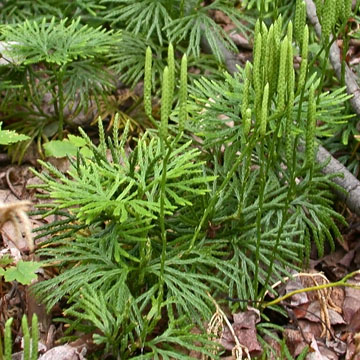

Diphasiastrum digitatum - (image 1 of 3)
Taxonomy
Family: Lycopodiaceae
Habitat
Acid soil in woods and on rocky slopes.
Associates
Distribution
Nova Scotia to Ontario, WI and MI, south to northern SC, northern GA, northern AL, TN, and IL. Disjunct in AR.
Morphology
Low evergreen from horizontal stems on the surface or just below soil level. Upright shoots with branchlets regularly fan-shaped, flattened, without annual constrictions. Leaves green, shiny, 4-ranked, upper leaves appressed, lateral leaves partially free with a spreading or incurved tip. Strobili mostly 2-3.5 cm long, terminal, often with sterile tips; peduncles mostly branching abruptly at base to produce a false whorl of strobili.
Notes
Spores produced August to September
Wetland indicator: FAC
This species is often confused with the circumboreal D. complanatum which produces new growth on old branchlets (evident as conspicuous annual bud constrictions).
References
Gleason, Henry A.
and A. Cronquist. 1991. Manual of Vascular Plants of Northeastern United States
and Adjacent Canada. Second Ed.
The New York Botanical Garden. Bronx, NY.
Swink, F. and G. Wilhelm. 1994. Plants of the Chicago Region.
Indiana Academy of Science. The Morton Arboretum. Lisle, Illinois.
USDA, NRCS. 2002. The PLANTS Database, Version 3.5 (http://plants.usda.gov).
National Plant Data Center, Baton Rouge, LA 70874-4490 USA.
Wagner, W.H. Jr. and Beitel, J.M. 1993. Lycopodiaceae. In: Flora of North America North of Mexico, Vol. 2.
Oxford University Press, New York and Oxford.
|
Michael Hough © 2005, 2018 |